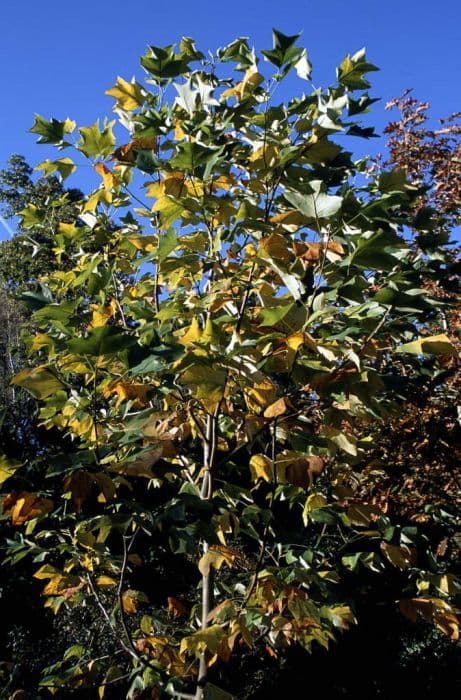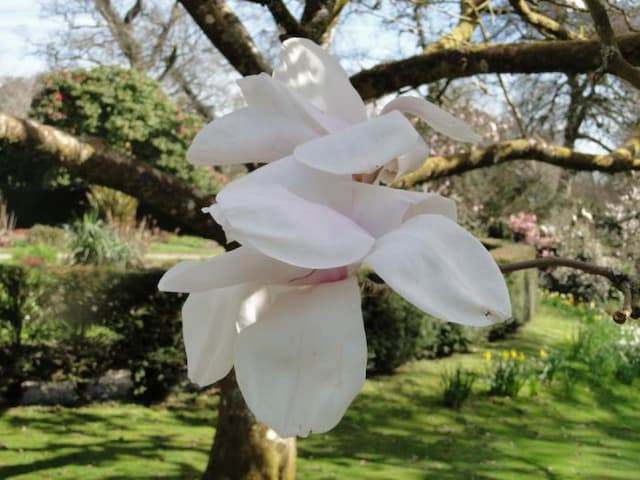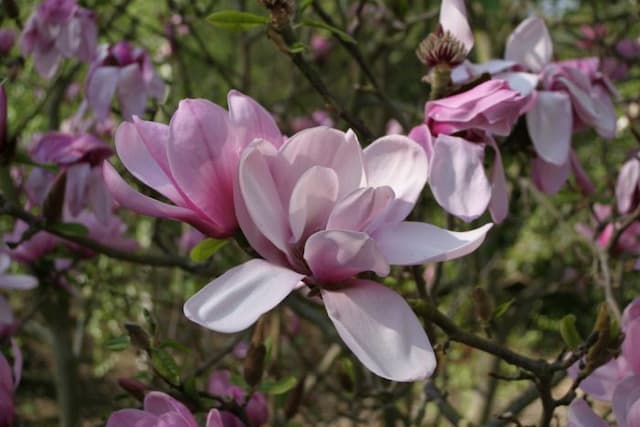Magnolia Magnolia 'David Clulow'

ABOUT
The Magnolia 'David Clulow' is a visually striking plant known for its large, showy flowers. The blooms are distinct, often characterized by a creamy white color with a hint of pink at the base, radiating a subtle fragrance. These flowers have a classic tulip shape and are sizeable, which adds to the plant's ornamental appeal. The petals are thick and waxy, giving them a lush, robust texture. The leaves of Magnolia 'David Clulow' provide a perfect backdrop for the flowers. They are glossy green, broad, and leathery, providing a dense canopy of foliage throughout the growing season. In the fall, the leaves may turn golden bronze, adding another layer of visual interest to the plant. The bark of the tree is smooth with a silvery-gray color, which looks quite attractive, especially in the winter months when the leaves have fallen, and the structure of the plant is more visible. The Magnolia 'David Clulow' typically has a pleasing, rounded shape with a branching habit that gives it a lush, full appearance, making it a popular choice for gardens and landscapes.
About this plant
 Names
NamesFamily
Magnoliaceae.
Synonyms
Magnolia 'David Clulow'.
Common names
Magnolia 'David Clulow'.
 Toxicity
ToxicityTo humans
The Magnolia is not typically considered poisonous to humans. However, it is always prudent to avoid ingesting plant parts that are not known to be edible. While there aren't any well-documented cases of severe toxicity from consuming Magnolia flowers, leaves, or bark, it is possible that individuals could experience mild stomach upset if parts of the plant are eaten in large quantities. It is also important to note that individual allergic reactions are possible with any plant material.
To pets
Magnolia plants are generally not considered toxic to pets. They do not contain any known toxins that are harmful to dogs or cats. Pets that ingest parts of a Magnolia, such as the leaves or flowers, may occasionally experience mild gastrointestinal upset, manifested as vomiting or diarrhea. However, such symptoms are not commonly reported and typically only occur if a large amount of plant material is ingested. It is always best to monitor pets and prevent them from chewing on or consuming plants to avoid any potential problems.
 Characteristics
CharacteristicsLife cycle
Perennials
Foliage type
Deciduous
Color of leaves
Green
Flower color
Pink
Height
10 feet (3 meters)
Spread
6 feet (1.8 meters)
Plant type
Tree
Hardiness zones
Varies
Native area
Asia
Benefits
 General Benefits
General Benefits- Aesthetic Appeal: Magnolias are known for their large, showy flowers that can add visual interest and beauty to a garden space.
- Fragrance: The flowers of Magnolia 'David Clulow' emit a pleasant fragrance that can enhance the sensory experience of a garden.
- Shade Provider: As a tree, it can offer shade and create a cool, sheltered area in the garden during hot summer months.
- Wildlife Habitat: Magnolias can provide food and shelter for birds, bees, and other wildlife, supporting biodiversity.
- Year-Round Interest: With its evergreen leaves and attractive bark, the plant can add interest to the landscape even when not in bloom.
- Low Maintenance: The Magnolia 'David Clulow' is typically a low-maintenance plant requiring minimal care once established.
 Medical Properties
Medical PropertiesThis plant is not used for medical purposes.
 Air-purifying Qualities
Air-purifying QualitiesThis plant is not specifically known for air purifying qualities.
 Other Uses
Other Uses- Culinary decoration: Magnolia petals can be candied to create elegant decorations for desserts, adding a floral note to the dish.
- Photographic subject: Magnolia trees, especially when blooming, offer a captivating subject for photographers seeking to capture the beauty of nature.
- Fabric dyeing: The bark and flowers of the magnolia can be used to create natural dyes for fabric, yielding soft, earthy colors.
- Horticultural grafting: Magnolia branches can be used in grafting to create new trees, combining different species or varieties for specific characteristics.
- Artistic inspiration: The striking appearance of the magnolia has inspired artists to incorporate its form into paintings, sculptures, and crafts.
- Perfumery: The essential oils extracted from magnolia flowers can be used in perfumery to give a pleasant, sweet scent to various fragrances.
- Woodworking: Although magnolias are not primarily known for their wood, their timber can be used for making small wooden objects or inlays in fine furniture.
Interesting Facts
 Feng Shui
Feng ShuiThe Magnolia is not used in Feng Shui practice.
 Zodiac Sign Compitability
Zodiac Sign CompitabilityThe Magnolia is not used in astrology practice.
 Plant Symbolism
Plant Symbolism- Perseverance: Magnolias are known to be tough and resilient, often blooming boldly before the leaves appear, symbolizing endurance and strength through hardships.
- Dignity: The magnolia's large and distinct flowers represent a noble spirit and a dignified character.
- Femininity: With its soft, delicate petals, the magnolia often symbolizes purity and the gentle side of femininity.
- Beauty: Magnolias are widely admired for their beauty. They are often associated with the natural beauty that doesn't require attention or validation.
- Love of Nature: The magnolia tree's connection to the earth and its steady, blooming presence symbolizes a deep appreciation for the natural world.
 Water
WaterThe David Clulow Magnolia needs consistent moisture, especially during its first few years and during the growing season. It's best to water deeply once a week, providing about 1 to 1.5 gallons depending on the size of the tree and weather conditions. If the weather is particularly hot or dry, you may need to water twice a week. The soil should remain moist, but not soggy. Overwatering can lead to root rot, so it's important to allow the soil to dry out slightly between watering sessions.
 Light
LightThe David Clulow Magnolia thrives in full sun to partial shade. An ideal spot is where the tree can receive at least four to six hours of direct sunlight per day. However, in hotter climates, some afternoon shade can be beneficial to prevent leaf scorch.
 Temperature
TemperatureThe David Clulow Magnolia prefers temperate climates and can generally tolerate temperatures as low as 20 degrees Fahrenheit and as high as 90 degrees Fahrenheit. The ideal temperature range for this magnolia is between 60 and 70 degrees Fahrenheit. It is sensitive to extreme cold and should be protected from harsh winter winds.
 Pruning
PruningPruning the David Clulow Magnolia is typically done to shape the tree, remove dead or damaged wood, and promote healthy growth. The best time to prune is in late winter or early spring, before new growth starts. Remove any crossing branches or those that disrupt the tree's structure. Pruning should be done sparingly, as magnolias don't require heavy pruning.
 Cleaning
CleaningAs needed
 Soil
SoilThe best soil mix for a Magnolia, commonly referred to as a Magnolia, is one that is rich, well-draining, and slightly acidic with a pH of about 5.5 to 6.5. A mix incorporating peat moss, compost, and a small amount of sand or perlite would provide a suitable growing environment for 'David Clulow'.
 Repotting
RepottingMagnolias, including the 'David Clulow' variety, generally require repotting every few years when they outgrow their current container. Since they are slow-growing, it might be necessary to repot every 3-5 years to ensure the roots have enough space to develop.
 Humidity & Misting
Humidity & MistingMagnolias like 'David Clulow' prefer moderate humidity levels, aiming for a range of 40-50%. Adequate air circulation is important to prevent fungal issues that can arise in too moist conditions.
 Suitable locations
Suitable locationsIndoor
For 'David Clulow' Magnolia, ensure bright, indirect light and room to grow.
Outdoor
Plant 'David Clulow' Magnolia in sun/partial shade, shelter from strong winds.
Hardiness zone
7-9 USDA
 Life cycle
Life cycleThe life of a Magnolia 'David Clulow' begins with seed germination, which typically occurs in moist, well-drained soil in early spring. After sprouting, the seedling undergoes a period of vegetative growth, developing a strong root system and foliage during its juvenile phase. As the plant matures, it enters the flowering stage, typically in mid to late spring, producing large, fragrant flowers that are white with shades of pink or purple. Following pollination, often by beetles attracted to the flowers, the plant produces cone-like fruit that releases seeds when mature, in late summer to early fall. The Magnolia 'David Clulow' continues to grow and can reach its mature size after several years, with the cycle of flowering and seed production repeating annually. In its mature phase, the plant may live for many years, sometimes for several decades, assuming favorable conditions are met for its survivability.
 Propogation
PropogationPropogation time
Spring-Early Summer
The most popular method for propagating Magnolia 'David Clulow', a unique variety of magnolia, is through softwood cuttings. This technique is often undertaken in late spring or early summer when the plant's growth is vigorous and the new stems are just beginning to harden. Gardeners should select a healthy, non-flowering shoot and make a cutting approximately 6 inches (15 cm) long, cutting just below a leaf node. The lower leaves are removed and the base of the cutting may be dipped in rooting hormone powder to increase the chances of successful rooting. The prepared cutting is then planted in a mix of peat and perlite, ensuring at least one node is buried where roots can develop. The environment should maintain high humidity, which can be achieved by covering the cutting with a plastic bag or placing it in a propagator. After several weeks, the cutting should have developed its own root system and can be gradually acclimatized to less humid conditions before eventually potting on.








![Magnolia [Felix Jury]](/_next/image?url=https%3A%2F%2Fplants-admin.emdemapps.com%2Fimages%2Fplants%2F%2Fimages%2F604b61a0b23b7.png&w=640&q=75)
